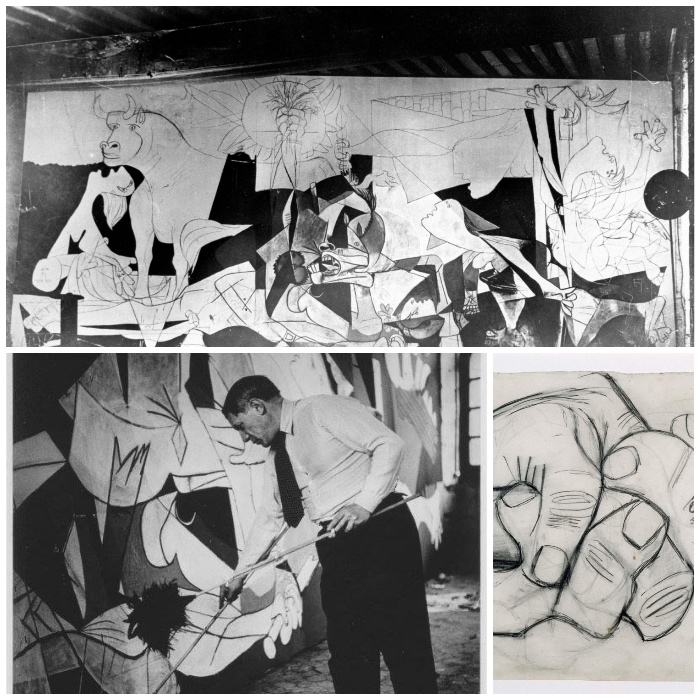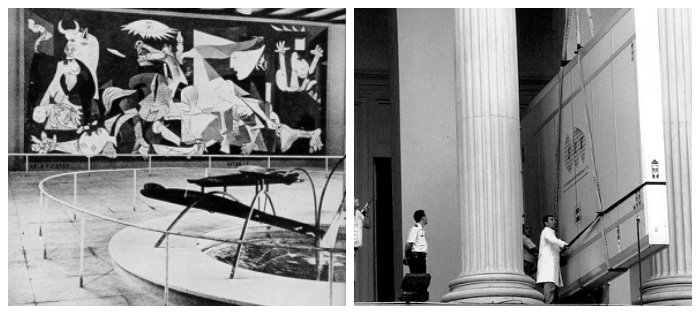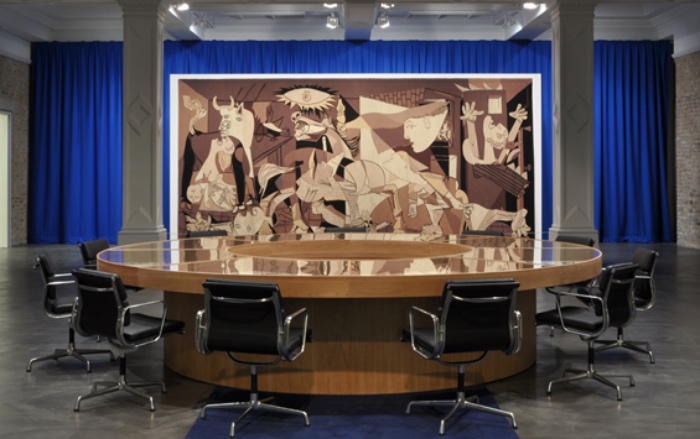GUERNICA BY PICASSO: 5 THINGS TO KNOW ABOUT THE MOST INTENSE PAINTING OF THE 20TH CENTURY
According to Picasso Guernica was the town that more than others had suffered the horrors of war.
This is the reason why Guernica became the subject of his most important masterpiece and the most representative work of the 20th century.
In this post you’ll find 5 things to know about Guernica.
READ ALSO: Pablo Picasso: 5 things to know.

Picasso al lavoro su Guernica.
1. WHEN AND WHY PICASSO PAINTED GUERNICA
When the Spanish Republican government commissioned Picasso to paint a painting to exhibit at the Paris International Exposition in 1937, Spain was ravaged by civil war. The Nationalist army, led by General Francisco Franco, and the Republican army were fighting on opposite sides, and Guernica was the scene of the most tragic episode of the civil war.
On April 26th 1937 the Luftwaffe (the German air force) bombed the Basque town of Guernica to intimidate the resistance, killing more than 2,000 people. When Picasso heard the news coming from Spain decided that that tragedy would be the subject of his painting, which would become the most intense work of the 20th century.
READ ALSO: 5 things to know about Maurits Cornelis Escher.
2. GUERNICA BY PICASSO: DESCRIPTION
The composition of the painting reflects the principles of Cubism with a series of figures flattened on one another and depicted from different points of views.
From left to right you can see a desperate mother holding a baby, wounded or maybe dead, in her arms.
Then you can see a bull, a symbol of Spain but also an element symbolizing strength and brutality, and the horse that Picasso declared to be the symbol of the people and their universal cry of pain.
On the left there’s a soldier, defeated, lying on the ground and holding in his hand a broken sword and a small flower, symbol of peace and rebirth.
The whole painting seems to be characterized by a strength pushing everybody to the left, while on the far right of the canvas you can see some flames destroying the bombed houses, and hitting a man who shouts and tries to escape.
3. WHY PICASSO PAINTED GUERNICA BLACK AND WHITE
Picasso didn’t see the bombing in person, but he knew the events from the newspaper of that time.
Picasso saw the black-and-white photos of the city of Guernica, so he decided to give his version of events to the world by painting the canvas white, black and gray, and making the scene even more dramatic.
READ ALSO: 5 things to know about Francis Bacon.

A destra: Guernica – Esposizione Universale di Parigi, 1937.
A sinistra: l’arrivo di Guernica a Madrid.
4. WHERE GUERNICA HAS BEEN EXHIBITED
The work was displayed at the Spanish Pavilion of the International Exposition of Art and Technology in Paris where it remained until the end of 1937.
Later Picasso gave the work to Spain, but he imposed a condition: the canvas would come back to his native land only after the restoration of democracy in Spain.
For this reason the work was housed at the Museum of Modern Art of New York (MoMA) for more than forty years, that is to say until 1981 when at last it was moved to Spain.
5. WHERE YOU CAN ADMIRE GUERNICA
On October 10th 1981 Guernica arrived in Madrid and was housed at the Casón del Buen Retiro. In 1992 Guernica was moved to the Museo Nacional Centro de Arte Reina Sofia (the Reina Sofia Museum) in Madrid, where is currently on display and from which it can’t be moved.

Guernica all’ONU
READ ALSO: Ai Weiwei, 5 things to know.



Sonó assolutamnte affascinata di arte da quando avevo nove, dieci anni ma, cinta dalla letteratura, diventata una modesta e timida boyeur …
L’arte rende la vita più poetica e tutti hanno bisogno di un po’ di poesia ogni giorno 😉
Guernica, solo facce storte? No ! “Solo ghiribizzi” (e non lo dice Ernesto, ma Pablo) di Ernesto Scura
ESAMINIAMO il GIGANTESCO FAMOSO “POSTER” DI PICASSO (non è un quadro ma un manifesto in bianco e nero).
ATTENZIONE: L’UOMO A TERRA CON IN PUGNO CIÒ CHE RESTA DI UNA SPADA,SECONDO LA VULGATA DI SINISTRA RAFFIGURA “UN SOLDATO CADUTO SOTTO I FEROCI BOMBARDAMENTI NAZIFASCISTI” E, SECONDO LA CRITICA PIÙ RIGOROSAMENTE COMUNISTA (democratica e socialitaria) NON PUÒ CHE ESSERE UN MILIZIANO ANTIFRANCHISTA. MA DOVE, MA QUANDO. (Addirittura,non ne era al corrente nemmeno Picasso che dovette apprenderlo da Carlo Giulio Argan, il famoso critico d’arte, quello che garantì, come autentiche opere di Modigliani, quelle teste scolpite col martello pneumatico, che un gruppetto di allegri studenti burloni e buontemponi fece “scoprire” nel greto di un torrente a Livorno). Picasso aveva quasi ultimato un poster con l’intento di commemorare la morte del suo amico, il torero Joselito, morto sotto il “bombardamento” delle… ”cornate” del toro salvo, poi, cambiargli il titolo in GUERNICA, per venire incontro alle richieste dell’UNIONE SOVIETICA, tramite il governo comunista spagnolo, che gli aveva commissionato un’opera che denunciasse al mondo la “ferocia dei bombardamenti nazifascisti sulla popolazione inerme”. Picasso fidando, giustamente, nella incomprensibilità dei suoi strani “ghiribizzi”, buoni per tutte le “stagioni” e per l’ormai scontata imbecillità dei critici e di quel vasto pubblico di “intenditori”, capaci di apprezzare e magari acquistare qualsiasi cacata, intendo proprio la merda, purchè firmata Picasso.Tanto, poi, ci avrebbero pensato i critici ad attribuirgli le appropriate “ispirazioni”. Siccome il compenso sovietico era cospicuo e siccome Picasso era sempre avido di soldi (fossero franchi, dollari o rubli ) e, siccome non aveva “tempo da perdere”, non gli costò nulla cambiare titolo al poster e invece che a Joselito fu dedicato a …GUERNICA. Bastò aggiungere una lampadina accesa, quella che campeggia in alto, nel poster, riuscendo a far fesso persino un delinquente feroce, agguerrito e smaliziato come STALIN. Dopo di che la schiera di stravaganti e stupidi critici è sempre pronta a dargli, con l’imprimatur, una giusta collocazione politica e…artistica. TENETE CONTO CHE PICASSO, OLTRE AD ESSERE UN PITTORE CUBISTA, ERA ANCHE UN CONVINTO SIMBOLISTA CHE NON HA MAI DISDEGNATO DI RAFFIGURARE (anche se a modo suo e con l’intento di “prendere per il culo”) GLI ELEMENTI PIÙ SIGNIFICATIVI DEI SUOI SOGGETTI, SENZA MASCHERATURE (la colomba della pace doveva essere individuabile : una colomba. Per far felice Stalin). Un torero rimaneva un torero, anche se col naso al posto dell’orecchio. Una donna, sempre una donna, anche se col pube al posto della narice) QUEL SOLDATO, SE SOLDATO DOVEVA ESSERE, DOVEVA ESSERLO DI QUEL CONTESTO E NON DELL’EPOCA DEI GLADIATORI (il realismo sovietico). CHE SENSO AVREBBE AVUTO METTERE IN PUGNO AD UN FANTOCCIO IN BORGHESE UN MONCHERINO DI SPADA (secondo gli sciocchi critici starebbe ad indicare che è un soldato. Ed allora,vivaddio, mettiamogli in mano una pistola ed in testa un berretto con la stella rossa). SECONDO MOLTI “GRANDI” CRITICI, PICASSO, IN QUELLA SUA COMPOSIZIONE, SI ERA ISPIRATO AL TEMA DELLA RAPPRESAGLIA, OPERATA DALL’INVASORE, SPLENDIDAMENTE RAFFIGURATA DA GOYA NELLA FUCILAZIONE DI PATRIOTI SPAGNOLI DA PARTE DEGLI OPPRESSORI NAPOLEONICI. MA LÌ, DAI VESTITI DEI MARTIRI E DALLE DIVISE DEI FUCILATORI SI CAPISCE BENISSIMO CHI È VITTIMA, DI CHI, E CHI AGUZZINO, DI CHI. MA VIA,SIAMO SERI. LA CRETINAGGINE, L’INSULSO ACCODARSI E LA COMODA E SICURA ASSUEFAZIONE ALLA VULGATA VINCENTE, A ME PROCURANO UN FASTIDIO… SE RIESCO A CAPIRE, MA NON A GIUSTIFICARE, L’AVIDITÁ DI QUEL MARPIONE DI PICASSO, ASSOLUTAMENTE NON RIESCO A POTER SOPPORTARE QUEI POVERI DI SPIRITO CHE NON SANNO MAI METTERE INSIEME UN PO’ DI IDEE PROPRIE E DEVONO RICORRERE, SENZA UN MINIMO DI SPIRITO CRITICO, ALLA TRANQUILLA COPERTURA DELLE STRONZATE DI CERTA CARTA STAMPATA. ASCOLTA, LETTORE, CHIUDI PER UN ATTIMO GLI OCCHI, IMMAGINA DI ESSERE SULLE TRIBUNE DI UNA PLAZA DE TOROS, IMMAGINAJOSELITO MORENTE PER LE CORNATE DEL TORO, RIVERSO A TERRA,CON IN PUGNO, ANCORA, I RESTI DELLA SUA ESPADA, IMMAGINA LE URLA DELLA FOLLA ESTERREFATTA PER QUELLA TRAGICA SCENA,IMMAGINA ANCORA LE MANI LEVATE AL CIELO DELLE DONNE “DOLENTI” (le prefiche) PER LA MORTE DEL MITICO TORERO, CERCA ANCORA DI RICORDARE I VERSI DI GARCIA LORCA PER L’ANALOGO PATHOS SUSCITATO DALLA MORTE DI IGNAZIO E, QUANDO APRIRAI GLI OCCHI, FORSE, FINALMENTE CAPIRAI L’ESSENZA DI QUEL “CAVOLO A MERENDA” CHE VUOL ESSERE QUELLA LAMPADINA (elettrica) ACCESA CHE ALTRO NON PUÒ ESSERE SE NON … “IL NUOVO” CHE AVANZA IN CONTRAPPOSIZIONE AL “VECCHIO” (il lume a petrolio). Il tutto fa parte di una simbologia adottata dagli artisti sovietici quando volevano significare il nuovo “illuminante” che avanza ( il comunismo) contro il vecchio che “non risplende più di tanto” (l’oscurantismo). In lingua russa: ”STAROE I NOVOE”, appunto come il titolo di film, di servile propaganda di regime, del regista Eisenstejn. IL TORO, per i critici “illuminati”, quelli un tanto al chilo, rappresenta il MINOTAURO, simbolo della feroce dittatura fascista, mentre noi, che fessi non siamo, sappiamo che voleva essere il toro che, con le sue cornate, abbattè JOSELITO. IL CAVALLO, col collo contorto,per i critici, sempre “un tanto al chilo”, vuol essere il popolo sofferente sotto il giogo della dittatura, ma noi, che fessi non siamo, sappiamo essere il cavallo de picadores, mortalmente ferito dal toro.
LE CONFESSIONI DI PICASSO
Picasso definiva “Ghiribizzi” i suoi scarabocchi eseguiti dopo il suo ancor splendido PERIODO BLU, a partire dal quale diede la stura a tutte le sue, purtroppo note, stravaganze cubiste “per vedere l’effetto che fa”. E l’effetto ci fu : Soldi a palate. Propongo la lettura di due documenti sconvolgenti che costituiscono una vera e propria confessione fatta, “in camera caritatis”, dal più noto pittore del secolo scorso a due rispettabilissimi esponenti della cultura mondiale :- Un brano di Matteo Perrini, pubblicato sul “Giornale di Brescia”,sulla base di una lettera olografa che lo stesso Picasso aveva scritto al famoso critico d’arte Bernard Berenson,definendo “GHIRIBIZZI” i suoi scarabocchi. – L’intervista che, nel 1951, Pablo Picasso concesse al nostro famoso scrittore GIOVANNI PAPINI. E PICASSO, E BERENSON E PAPINI, OLTRE CHE ESSERE GALANTUOMINI E GENTE D’ONORE SONO DEGNI DI CREDIBILITÀ, SPECIALMENTE PICASSO. In entrambi i documenti Picasso sente il bisogno di “confessarsi”, certamente in considerazione dell’alta valenza culturale dei due emeriti personaggi.
LETTTERA A BERNARD BERENSON
Pablo Picasso in una lettera al suo amico Bernard Berenson, famoso critico d’arte, pubblicata poi nella NeueillustrierteWochenschau del 24 ottobre 1971 fa delle sconcertanti rivelazioni. In essa l’artista più famoso del nostro tempo si duole, e con profonda amarezza, di aver ben presto dato al pubblico quello che il pubblico gli chiedeva, rinnegando con intimo disgusto, o comunque mettendo tra parentesi, le esigenze più schiette dell’arte. Le sue dichiarazioni sono così significative che meritano di essere citate per intero. «Ho soddisfatto questi amatori del nuovo e dell’eccentrico con i ghiribizzi che mi passavano per la testa e quanto meno li comprendevano tanto più li ammiravano! Divertendomi con questi giochetti divenni ricco e celebre, e questo assai presto. Ma quando sono solo con me stesso, non ho il coraggio di ritenermi un artista nel significato grande e nobile della parola. Sono solo un pubblico burlone che capisce il suo tempo e che ha sfruttato la stupidità, la vanità e l’avidità dei suoi contemporanei»
PABLO PICASSO INTERVISTATO DA PAPINI : Da Giovanni Papini “Il libro nero” 1951. Antibes -“VISITA A PICASSO” Molti anni fa avevo comprato a Parigi sei quadri di Picasso, non perchè mi piacessero ma perchè eran di moda ed io potevo servirmene per fare dei regali alle signore che mi invitavano a pranzo. Ma ora, trovandomi sulla Côte d’Azur e non sapendo come passare le giornate, m’è venuta la voglia di vedere in viso l’autore di quelle pitture. Vive qua vicino, in una villa sul mare, con una giovanissima e florida moglie. Ha, credo, sessantacinque o sessantasei anni ma è di buon sangue catalano, forte e ben formato, di bel colore e di bell’umore. S’e parlato, sulle prime, di certi comuni conoscenti ma ben presto il discorso si é fermato sulla pittura. Pablo Picasso non è soltanto un artista felice ma anche un uomo intelligente, che non ha paura di sorridere, a tempo e a lungo, delle teorie dei suoi ammiratori. -Voi no siete un critico ed un esteta, mi ha detto, e con voi posso parlare liberamente. Da giovane, come tutti i giovani, ho avuto anch’io la religione dell’arte. Ma poi, col passar degli anni, mi sono accorto che l’arte, come s’intendeva fino a tutto l’Ottocento, è ormai finita, moribonda, condannata e che la cosiddetta “attività artistica”, con la sua stessa abbondanza, non è che la multiforme manifestazione della sua agonia. Gli uomini vanno sempre più disaffezionandosi di pitture, sculture e poesie, nonostante le contrarie apparenze. Gli uomini di oggi hanno messo il loro cuore in tutt’altre cose: le macchine, le scoperte scientifiche, la ricchezza, il dominio delle forze naturali e delle forze del mondo. Non sentono più l’arte come bisogno vitale, come necessità spirituale, a somiglianza di quel che in altri secoli accadeva. Molti di loro seguitano a fare gli artisti e ad occuparsi di arte, ma per ragioni che con l’arte Vera hanno poco a che vedere, cioè per spirito d’imitazione, per nostalgia della tradizione, per forza d’inerzia, per amore del lusso, dell’ostentazione, della curiosità intellettuale, per moda e per calcolo. Vivono ancora, per abitudine e snobismi, in un recente passato, ma la grande maggioranza, in alto e in basso, non ha più una sincera e calda passione per l’arte, che considera, tutt’al più come spasso, svago e ornamento. “Un artista che vede chiaro in questa fine prossima, come è avvenuto a me, cosa può fare? Troppo duro partito sarebbe quello di cambiar mestiere, e pericoloso dal punto di vista alimentare. Ci sono, per lui, soltanto due strade: cercare di divertirsi e cercare di fare quattrini. Dal momento che l’arte non è più il cibo che alimenta i migliori, l’artista può sfogarsi a suo talento in tutti i tentativi di nuove formule, in tutti i capricci della fantasia, in tutti gli espedienti del ciarlatanismo intellettuale. Nell’arte il popolo non cerca più consolazione ed esaltazione; ma i raffinati, i ricchi, gli oziosi, i lambiccati di quintessenze, cercano il nuovo, lo strano, l’originale, lo stravagante, lo scandaloso. Ed io, dal cubismo in poi, ho accontentato questi signori e questi critici con tutte le mutevoli bizzarrie che mi son venute in testa, e meno le capivano e più mi ammiravano. A forza di spassarmela con tutti questi giochi, con queste funambolerie, con i rompicapo, i rebus e gli arabeschi, son diventato celebre abbastanza presto. La celebrità significa, per un pittore, vendite, guadagni, fortuna, ricchezza. E ora, come sapete, son celebre, son ricco. Ma quando sono solo, fra me e me, non ho il coraggio di considerarmi un artista nel senso grande e antico della parola. Veri pittori furono Giotto e Tiziano, Goya e Rembrandt: io sono soltanto un “amouseur public” che ha capito il suo tempo e ha sfruttato come meglio ha saputo,l’imbecillità, la vanità, e la cupidigia dei suoi contemporanei. Ė un’amara confessione, la mia, più dolorosa di quel che vi possa sembrare, ma ha il merito di essere sincera. “Et , “après ça, ha concluso Picasso, “allons boire”. La conversazione non è finita quì ma non ho più la pazienza di registrare gli altri paradossi che sono usciti dalle labbra del vecchio pittore catalano.
Ernesto Scura
caro Ernesto,
nessuno ha chiesto il tuo messaggio.
Quindi è inutile che sprechi tutto questo tempo per scrivere anche se sai che nessuno lo leggerà
La prossima volta magari fai un riassunto o usa un sito per farli (fai prima a non scriverli)
Arrivederci
sto scherzando
in fondo ti voglio bene 🙂
Qualcuno legge, ma la domanda è perchè perdere tempo con messaggi come questo?